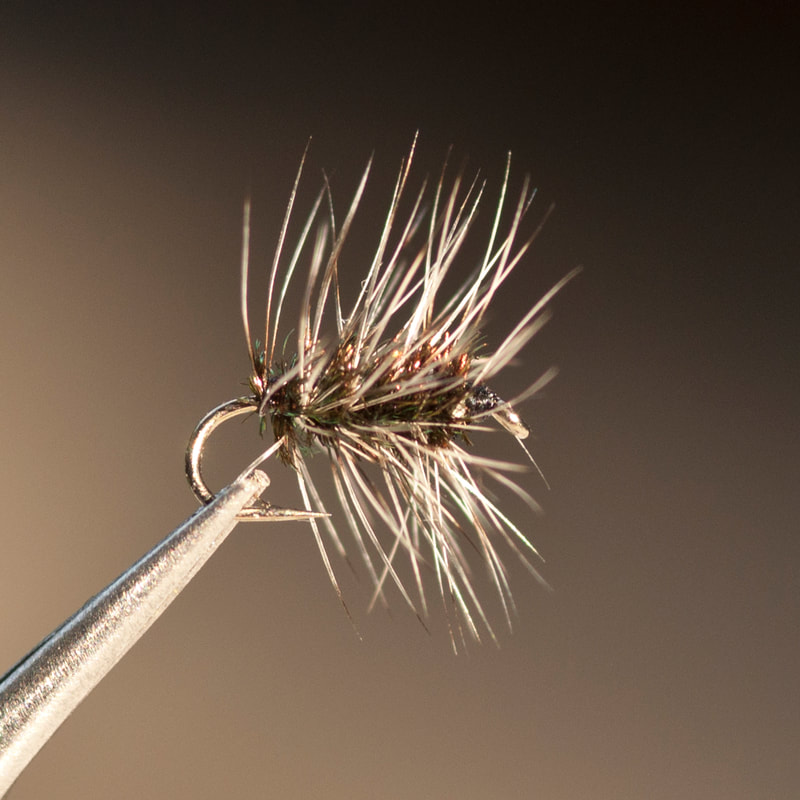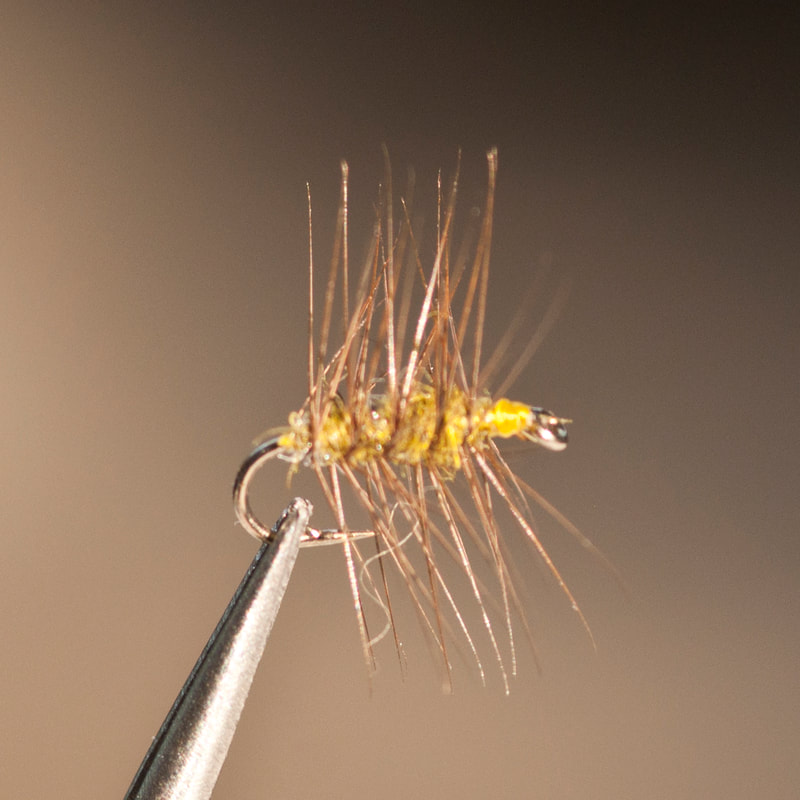Fly of the Month
Our last article for 2015 is in five parts, Midges or diptera. Part One will cover the unique midge cluster, Part Two will cover the adult stage, Part Three will cover the Emerger stage, Part Four will cover the pupa stage and Part Five in January 2016 will cover the larva stage.
Midges appear to be available to trout on all streams including small freestones, large rivers, spring creeks, tailraces and the still waters of ponds, lakes and reservoirs. It is quite amazing that trout eat these very small aquatic insects. However, if you consider the massive number of midges in a square foot of bottom or in a midge hatch, one realizes the significance of this food source. Of course the problem to deal with for the fly fisher is how you imitate these very, very small aquatic insects.
Midge adults that swarm on the surface are typically emerging, flying, mating, laying eggs or dying once spent – much like other aquatic insects. For years anglers have tied very small midge imitations in size 18 to size 24; for some extreme anglers, even size 26 to size 32 for Spring Creeks and English Chaulk Streams. However, one unique opportunity for the angler is the times that midges cluster together. Midges will cluster while emerging, mating and while laying eggs since they are busy and unable to fly. Midges will also cluster due to a breeze pushing their masses together, especially once spent.
Since a midge cluster is multiple midges, the size of the cluster allows for a larger imitation down to a size 16 or size 14. The fly that has become famous for imitating a midge cluster is Griffith’s Gnat.
Griffith’s Gnat
George Griffith, the founders of Trout Unlimited, created this unique midge imitation. The beauty of the fly is how it floats half in and half out of the surface film much like a midge cluster or possibly representing something stuck, trying to emerge from its shuck. Generally a midge cluster floating on the water has the appearance of a gob of grayish matter.
Tying a Griffith’s Gnat is very simple and easy. The most basic version is a palmered grizzly hackle directly tied on the hook. Of course there are various colors of midges and the grayish matter often takes on an embedded color that the trout may key on. The original fly pattern has a peacock herl as the body with grizzly hackle, palmered or overwound. A dubbed body of practically any color may be used to imitate a cluster of Chironimid of a given color. New synthetic materials such as braid may be used to create a body of a sparkling color.
Besides the original Griffith’s Gnat with a peacock herl body the Black Griffith’s Gnat with a black dubbed body which imitates polypedilum nubeculosus is probably next in importance to the angler. Two other colors most often tied and utilized are the Cream Griffith’s Gnat and the Olive Griffith’s Gnat.
Fish the Griffith’s Gnat most effectively in back eddies, rainwater butts and slack waters near where debris accumulates on the surface. The Griffith’s Gnat can be effective in moving water as well. Anglers believe that the Griffith’s Gnat appears to be a larger, emerging insect shucking its nymphal shell on the surface rather than a midge cluster when fishing in the stream flow.
Griffith’s Gnat
Black Griffith’s Gnat
Cream Griffith’s Gnat
Olive Griffith’s Gnat
Fly of the Month 9.15
- Tom Adams, Alen Baker
Our last article for 2015 is in five parts, Midges or diptera. Part One will cover the unique midge cluster, Part Two will cover the adult stage, Part Three will cover the Emerger stage, Part Four will cover the pupa stage and Part Five in January 2016 will cover the larva stage.
Midges appear to be available to trout on all streams including small freestones, large rivers, spring creeks, tailraces and the still waters of ponds, lakes and reservoirs. It is quite amazing that trout eat these very small aquatic insects. However, if you consider the massive number of midges in a square foot of bottom or in a midge hatch, one realizes the significance of this food source. Of course the problem to deal with for the fly fisher is how you imitate these very, very small aquatic insects.
Midge adults that swarm on the surface are typically emerging, flying, mating, laying eggs or dying once spent – much like other aquatic insects. For years anglers have tied very small midge imitations in size 18 to size 24; for some extreme anglers, even size 26 to size 32 for Spring Creeks and English Chaulk Streams. However, one unique opportunity for the angler is the times that midges cluster together. Midges will cluster while emerging, mating and while laying eggs since they are busy and unable to fly. Midges will also cluster due to a breeze pushing their masses together, especially once spent.
Since a midge cluster is multiple midges, the size of the cluster allows for a larger imitation down to a size 16 or size 14. The fly that has become famous for imitating a midge cluster is Griffith’s Gnat.
Griffith’s Gnat
George Griffith, the founders of Trout Unlimited, created this unique midge imitation. The beauty of the fly is how it floats half in and half out of the surface film much like a midge cluster or possibly representing something stuck, trying to emerge from its shuck. Generally a midge cluster floating on the water has the appearance of a gob of grayish matter.
Tying a Griffith’s Gnat is very simple and easy. The most basic version is a palmered grizzly hackle directly tied on the hook. Of course there are various colors of midges and the grayish matter often takes on an embedded color that the trout may key on. The original fly pattern has a peacock herl as the body with grizzly hackle, palmered or overwound. A dubbed body of practically any color may be used to imitate a cluster of Chironimid of a given color. New synthetic materials such as braid may be used to create a body of a sparkling color.
Besides the original Griffith’s Gnat with a peacock herl body the Black Griffith’s Gnat with a black dubbed body which imitates polypedilum nubeculosus is probably next in importance to the angler. Two other colors most often tied and utilized are the Cream Griffith’s Gnat and the Olive Griffith’s Gnat.
Fish the Griffith’s Gnat most effectively in back eddies, rainwater butts and slack waters near where debris accumulates on the surface. The Griffith’s Gnat can be effective in moving water as well. Anglers believe that the Griffith’s Gnat appears to be a larger, emerging insect shucking its nymphal shell on the surface rather than a midge cluster when fishing in the stream flow.
Griffith’s Gnat
Black Griffith’s Gnat
Cream Griffith’s Gnat
Olive Griffith’s Gnat
Fly of the Month 9.15
- Tom Adams, Alen Baker
Griffith’s Gnat
Hook : Tiemco 100 or equivalent. Size 24,22,20,18,16
Thread : Black Uni 8/0 or equivalent
Body : Peacock herl
Hackle : Rooster dry, grizzly
Directions :
Hook : Tiemco 100 or equivalent. Size 24,22,20,18,16
Thread : Black Uni 8/0 or equivalent
Body : Peacock herl
Hackle : Rooster dry, grizzly
Directions :
- Debarb the hook and mount in the vise. Begin the thread two eyelengths from the eye and wrap to the hook bend in tight, touching turns. Let the bobbin hang.
- Select a rooster hackle with barbs about one and one half the width of the hook gape. Strip about 3/16ths of an inch of barbs from both sides of the feather shaft. Tie in the hackle at the rearmost point with the concave or dull side of the hackle facing the hook eye. When tying in, make sure there is sufficient feather shaft exposed to allow for one full wrap without any barbs flaring. This will make a neater tie with less “clumping” of barbs at the start point. Let the bobbin hang.
- Select a peacock herl feather and notice the barbs are longer on one side of the feather shaft. Tie in the herl with the longer fibers away from the hook shank. Don’t tie in very close to the tip of the herl, but, about a half to three quarters of an inch from the tip due to the fragility of the feather shaft.
- Advance the thread in tight touching turns to two eyelengths from the eye and let the bobbin hang.
- Begin wrapping the herl in tight, touching turns, being careful to not twist the herl when making the rotation. Tie off at two eyelenghts from the eye and trim away the waste. Let the bobbin hang.
- Wrap the grizzly rooster hackle forward in tight, but not touching turns, advancing to the end of the herl and tie off. Trim waste.
- Form a small thread head and whip finish.



